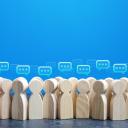The Reva and David Logan Center for the Arts and the University’s new Arts Incubator sit just a mile apart, separated only by a short walk through Frederick Law Olmsted’s Washington Park. Yet it’s a walk many Chicagoans have never taken.
A new exhibition presented by the University’s Arts and Public Life initiative, the Center for the Study of Race, Politics and Culture and Logan Center Exhibitions hopes to challenge the perception of separation between the two spaces and their surrounding communities, and encourage residents to explore “The Distance Between.”
The exhibition runs through Sunday, Sept. 29 in the galleries of both the Arts Incubator and the Logan Center and on the path between them.
“It’s a physical distance, a theoretical distance, a conceptual distance,” said Allison Glenn, who co-curated “The Distance Between” with Monika Szewczyk.
Because the exhibition cannot be viewed in its entirety without traveling between the Logan Center and the Arts Incubator, Glenn sees “The Distance Between” as “a call to action. It’s asking people to consider and traverse the space,” she said.
The five artists participating in the exhibition will come together for a series of performances and a crossing of Washington Park at 3 p.m. on Sunday, Sept. 15. Visitors can start at either location and travel across the park by foot, bike or bus. Buses will depart every 30 minutes from each location between 4 and 6 p.m., with final trips ending at the opening of Suicide Narcissus at the Renaissance Society.
Cellist Tomeka Reid will perform an improvised duet, the Washington Park Suite, which takes inspiration from pivotal moments in the history of the Washington Park community and incorporates ambient sound from the area recorded by Norman Long. The piece will be performed at the Arts Incubator and Logan Center simultaneously, with Reid, fellow cellist Fred Lonberg-Holm and sound manipulators Todd Carter and Alex Inglizian collaborating in real time over a live web stream.
Reid has experimented with web-based improvisation once before, and thought it could help bring the theme of the exhibition to life. “We are literally crossing the park via the Internet,” she said.
Experiencing art across different spaces is “a really exciting adventure for people to take,” said poet avery r. young. Several of young’s poems on found material will be on display in the galleries of the Logan Center and the Arts Incubator throughout the exhibition, along with a sound piece, choir rehearsal.
Although the artists mostly worked on their projects for “The Distance Between” independently, young said common themes and preoccupations emerged. “It’s amazing to see how these works are in conversation with each other, even though we weren’t in conversation with each other about the work,” he said.
“The Distance Between” is the culminating exhibition for the 2012-2013 Arts and Public Life/Center for the Study of Race, Politics and Culture artists-in-residence. The 10-month residency program aims to advance the ambitions of Chicago-based artists whose work engages questions of race, ethnicity and community. Along with Reid and young, the 2012-2013 artists-in-residence are musician LeRoy Bach, photographer Cecil McDonald, Jr. and filmmaker Cauleen Smith.
Both Reid and young said the residency offered a chance to explore new avenues in their practice.
“I’m a writer and a performer. Usually all I need is a piece of paper or the poem memorized,” young said. “This particular experience really enabled me to explore ways that language can be applied onto and within other materials. That was really the most exciting part of this residency—to see myself expand with the use of materials.”
For Reid, who lives on the South Side, the location of the artist-in-residence program set it apart from other programs. “With other residencies, you go away and hopefully come back with the energy to continue what you started in the residency.”
Reid said it was especially valuable and meaningful to have the opportunity to connect with the Washington Park community. “I’m grateful the residency is here for creative people to take part in, especially on the South Side, where we need more opportunities like that.”
Washington Park found its way into young’s work as well. “I got my hair cut at the barber shop, I got food at Miss Lee’s, I got pop at the corner store,” he said. “I collected language from people in the neighborhood and applied that to the work. You engage and you explore.”






